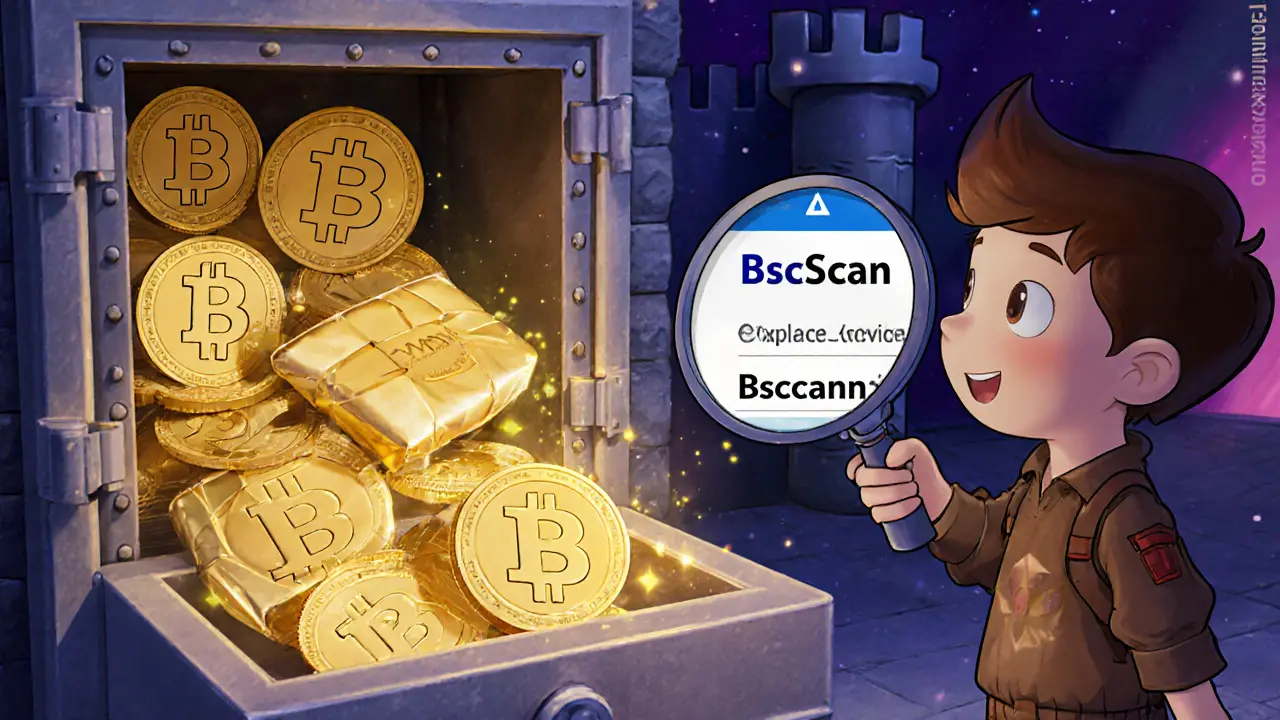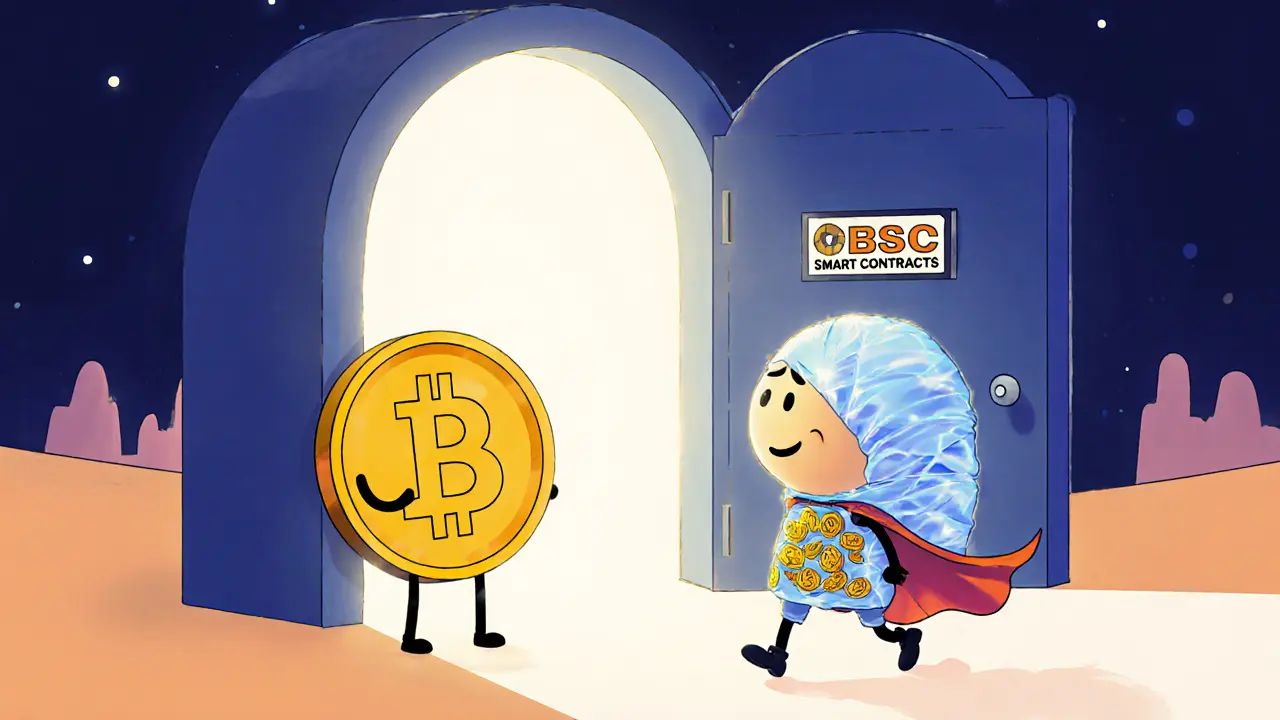WBNB Transaction Fee Calculator
Calculate Your Fees
Results
Note: Average gas fee is $0.07 per transaction. Binance charges 0.1% fee on the BNB amount. Fees are in USD based on current $BNB price.
Wrapped BNB isn’t a new cryptocurrency-it’s BNB, but dressed up to work in DeFi. If you’ve ever tried to use BNB on PancakeSwap, Venus, or any other DeFi app on Binance Smart Chain and got an error, chances are you needed WBNB. Native BNB can’t interact with smart contracts. Wrapped BNB can. That’s the whole point.
Why Wrapped BNB Exists
Binance Coin (BNB) was built for one main job: paying fees on the Binance exchange and acting as gas on the original Binance Chain. But when Binance launched its second blockchain-the Binance Smart Chain (BSC)-in September 2020, they needed a way for BNB to interact with decentralized apps. Smart contracts on BSC only understand BEP-20 tokens. Native BNB doesn’t fit that mold. So they created WBNB: a BEP-20 token that’s 1:1 backed by BNB. Think of it like exchanging a U.S. dollar bill for a digital voucher you can use in a specific store. The voucher is worth exactly one dollar. You can spend it inside the store, but you can’t use it at the grocery store unless you turn it back into cash. WBNB works the same way. You wrap BNB to use it in DeFi. You unwrap it to use it on Binance or pay gas fees.How WBNB Works: The Wrapping Process
The wrapping process is automatic and happens through a smart contract. Here’s how it works in simple steps:- You send BNB to the official WBNB smart contract on BSC.
- The contract locks your BNB in a secure vault.
- It mints an equal amount of WBNB and sends it to your wallet.
- To reverse it, you send WBNB back to the contract.
- The contract burns your WBNB and releases your original BNB.
WBNB vs Native BNB: Key Differences
Many people confuse WBNB and BNB as interchangeable. They’re not. Here’s what each one can and can’t do:| Function | WBNB | Native BNB |
|---|---|---|
| Used in DeFi apps (PancakeSwap, Venus, etc.) | Yes | No |
| Pays BSC gas fees | No (you need BNB) | Yes |
| Used to trade on Binance.com | No | Yes |
| Eligible for Binance Launchpad sales | No | Yes |
| Can be staked in Binance Savings | No | Yes |
| 1:1 value peg to BNB | Yes (deviations under 0.1%) | Yes |

Where WBNB Is Used
WBNB is the backbone of BSC’s DeFi ecosystem. Over 78% of trading pairs on PancakeSwap use WBNB as the base token. That means if you’re swapping tokens on BSC, you’re almost certainly trading against WBNB. It’s also the main asset in:- Liquidity pools on PancakeSwap
- Yield farming on Beefy Finance
- Lending and borrowing on Venus Protocol
- Staking on BakerySwap
Security and Risks
WBNB is backed by Binance, one of the most trusted names in crypto. Its smart contracts have been audited three times by top firms like CertiK and PeckShield. No critical vulnerabilities have been found since 2022. But it’s not perfect. Because the wrapping process relies on a centralized smart contract (not a decentralized multi-sig like WBTC), there’s a single point of failure. If the contract gets hacked or Binance shuts it down, WBNB could lose its peg. That’s a risk most users accept because Binance has never failed to honor its obligations. There’s also the risk of phishing. Fake wrapping contracts look identical to the real one. Always verify the contract address on BscScan before sending any funds. The official WBNB contract address starts with 0xbb4CdB9CBd... and is listed on Binance’s official docs.Transaction Costs and Speed
WBNB transactions use BSC’s gas fees, paid in BNB. Average fees range from $0.05 to $0.10 per transaction. That’s 100x cheaper than Ethereum. Wrapping or unwrapping WBNB takes under a minute. Binance’s internal tests show an average redemption time of 2.7 minutes across 15,000 transactions. That’s faster than most cross-chain bridges. The only fee you pay is the gas fee. Binance charges a 0.1% fee for wrapping/unwrapping, which is standard across platforms.
Getting Started with WBNB
If you want to use WBNB, here’s how:- Connect your wallet (MetaMask, Trust Wallet, etc.) to the Binance Smart Chain network.
- Make sure you have some BNB in your wallet for gas fees.
- Go to PancakeSwap’s ‘Wrap’ function or Binance’s official bridge.
- Enter the amount of BNB you want to wrap.
- Confirm the transaction. You’ll get WBNB in your wallet instantly.
What’s Next for WBNB?
In October 2023, Binance announced WBNB 2.0-a major upgrade that will let WBNB move across multiple blockchains, including Polygon and Avalanche. This is a big deal. Right now, WBNB only works on BSC. With WBNB 2.0, you could use it on Ethereum, Solana, or other chains without needing to bridge. There’s also talk of integrating WBNB into the BEP-1155 standard, which would let it be used in NFT games and digital collectibles on BSC. That could open up new use cases beyond DeFi. Analysts predict WBNB’s circulating supply could grow from 1.3 million to over 2 million tokens by the end of 2024, driven by rising DeFi adoption on BSC.Should You Use WBNB?
If you’re trading, farming, or lending on BSC, you need WBNB. There’s no workaround. If you’re holding BNB for long-term value or plan to trade on Binance.com, keep your BNB native. WBNB isn’t an investment. It’s a utility token. Its value doesn’t come from speculation-it comes from being the only way to access BSC’s DeFi ecosystem. If you’re active in DeFi, you’ll use it. If you’re not, you don’t need it. The bottom line: WBNB solves a real problem. It lets BNB do what it was never designed to do. And for that, it’s become indispensable.Is WBNB the same as BNB?
No. WBNB is a tokenized version of BNB that works on the Binance Smart Chain. It’s pegged 1:1 to BNB, but it can’t be used to pay exchange fees or enter Binance Launchpad sales. Native BNB is used for those purposes. WBNB is only for DeFi apps.
Can I earn interest on WBNB?
Yes. You can stake WBNB in liquidity pools on PancakeSwap or use yield aggregators like Beefy Finance to earn interest. Many users report 5-20% APY depending on the pool. But remember: you need to wrap your BNB first to do this. You can’t earn interest on native BNB in DeFi.
Is WBNB safe?
WBNB is one of the safest wrapped tokens because it’s backed by Binance and has undergone multiple audits. The smart contract has no known critical flaws. But like all DeFi, you risk losing funds if you interact with fake contracts. Always double-check the official contract address on BscScan before sending tokens.
Do I pay fees to wrap or unwrap WBNB?
Yes. Binance charges a 0.1% fee for wrapping or unwrapping WBNB. You also pay a gas fee in BNB to confirm the transaction on BSC. Gas fees are typically $0.05-$0.10. So for every $1,000 you wrap, you’ll pay about $1 in fees total.
Can I convert WBNB back to BNB anytime?
Yes. You can unwrap WBNB back to BNB at any time using the same platforms you used to wrap it-PancakeSwap, Binance Bridge, or any wallet that supports BSC. The process is instant and reversible. Your original BNB is always locked and secured until you request it back.
Why not just use BNB directly on DeFi?
Because BNB isn’t a BEP-20 token. Smart contracts on BSC only accept BEP-20 tokens like WBNB, BUSD, or USDT. Native BNB is a native coin, like ETH on Ethereum. It can’t be used in contracts unless it’s wrapped. That’s a technical limitation of how blockchains are built.
Is WBNB better than WBTC or WETH?
It’s not better-it’s different. WETH and WBTC are for Ethereum. WBNB is for Binance Smart Chain. Each serves its own ecosystem. WBNB is cheaper to use, faster to wrap, and more integrated into its network than WBTC is on Ethereum. But WBTC has broader multi-chain support. Choose based on which blockchain you’re using.

Joy Whitenburg
November 11, 2025 AT 15:34Stephanie Platis
November 13, 2025 AT 06:19Phil Bradley
November 13, 2025 AT 13:09Ruby Gilmartin
November 14, 2025 AT 13:02James Ragin
November 15, 2025 AT 18:09Atheeth Akash
November 16, 2025 AT 17:06Michael Brooks
November 17, 2025 AT 04:43Michelle Elizabeth
November 17, 2025 AT 08:26Elizabeth Stavitzke
November 18, 2025 AT 14:14FRANCIS JOHNSON
November 20, 2025 AT 12:34Noriko Yashiro
November 21, 2025 AT 21:21Douglas Tofoli
November 22, 2025 AT 02:51Diana Dodu
November 23, 2025 AT 06:31David Billesbach
November 24, 2025 AT 17:44William Moylan
November 25, 2025 AT 04:22Michael Faggard
November 27, 2025 AT 01:27Andy Purvis
November 28, 2025 AT 20:28Kylie Stavinoha
November 30, 2025 AT 06:17